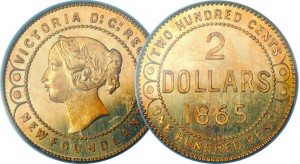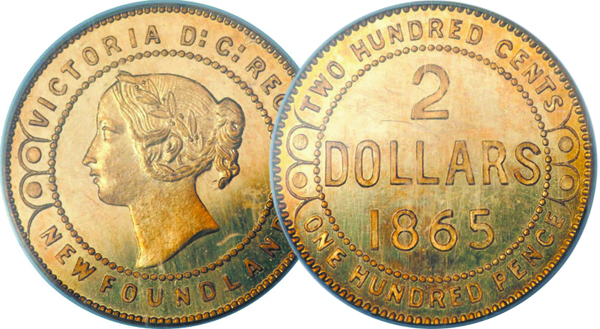
The scarce pattern made prior to the production of Newfoundland $2 gold coins differs from the final coin in small details, such as the dots and lines on either side of the obverse effigy.
A pattern 1865 gold $2 from Newfoundland changed hands for more than $100,000 at the Heritage Auction held April 10 in Chicago.
The coin, sold during the sale of the Prager collection of Canadian Specimen coins at the Chicago International Coin Fair, sold for $102,812.50 US. ($113,000 Cdn), which includes a 17.5 per cent buyer’s fee. It was graded PCGS SP-63. Newfoundland struck $2 gold coins on and off between 1865 and 1888. The coins are the only gold coins in the Maritimes series, as well as being unique in being denominated three ways on the reverse: “2 dollars” appears in the centre, with “two hundred cents,” above and “one hundred pence” below.
The patterns were produced in advance for design approval, as was common practice at that time. In this case the design was modified slightly for the final coin, with the obverse side simplified with the removal of several dots and lines.
Only two patterns are believed to exist, one in a British museum, and the other being available to collectors. That example has a lineage tracing back to the 1954 sale of the King Farouk collection. At that sale it was purchased for the Norweb collection and remained there until the collection was sold in 1996. At that time it realized nearly $40,000 US.
The Heritage example is believed to be the same coin sold in 1910 by auctioneer firm Spinks, the first known appearance of an 1865 $2 Newfoundland pattern. According to Heritage, the coin sold in their auction was the one known to have appeared in the past century.
Rare cents sold
Two examples of the 2005P non-magnetic cents changed hands recently, both sold by the Canadian Numismatic Company of Quebec City, Que.
The first example, at the firm’s March 29, mail bid sale, sold for $19,250. The second sold a few days later by private treaty for $18,000. The first coin was graded ICCS MS-67 NBU, and the second ICCS MS-66 NBU.
The P designation was used in 2005 to distinguish coins made with Canadian planchets with steel cores which are attracted to a magnet, while coins struck on imported planchets with non-ferrous zinc cores, did not have the mark.
Canadian collectors normally use the terms magnetic, to describe steel-cored cents, and non-magnetic for zinc-cored cents.
The 2005P non-magnetic coins were created when the RCM struck coins on zinc-cored blanks using dies intended for steel-cored blanks. It is not known if the errors were created when the wrong die was used, or if the wrong blanks were used, or if just a few zinc blanks got mixed in with steel ones, but very few 2005P non-magnetic coins are known to exist.
In 2006 error coins were also produced, both 2006P on non-magnetic cores and 2006 on magnetic cores. While scarce, the 2006 errors are not as highly valued, selling for hundreds rather than thousands of dollar. A non-error 2005 or 2005P cent can be purchased for under $1.
NBU, or Numismatic Brilliant Uncirculated, is the term used to describe coins sold in Uncirculated sets rather than issued in rolls as business strikes. The fact that both coins have the designation, imply that the error coins may only exist in sets.
The realization was quoted before buyer’s premium and taxes.

